An interview with Katherine Ponte, founder of Ecostasy.
Most companies talk green, but few—almost none in fact—actually walk the walk. Sustainable design company, Ecostasy, not only walks the walk, but actually seeks out among the most challenging places to work: the imperiled Brazilian Amazon. Specializing in hand-crafted products by indigenous groups—such as jewelry, pots, and furniture—Ecostasy seeks to balance smart economics, environmental protection, and community development. Make no mistake, however, Ecostasy is not a non-profit, but a rare and refreshing example of a company truly dedicated to changing the world for the better.
“In my mind, a virtuous company does not compromise ethical principles for economic interests. For me, being ethical is comprised of conducting oneself with honesty and responsibility to one’s constituencies (customers, employees, suppliers), society and the environment,” Katherine Ponte, founder of Ecostasy, told mongabay.com in an interview.
Ecostasy currently works with seven different indigenous groups. These partnerships have proven rewarding for all sides.
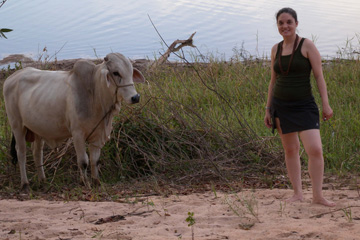 Katherine Ponte of Ecostasy in Brazil. Photo courtesy of Ecostasy. |
“Handcrafted objects celebrate one of the highest forms of sustainable production—preserving communities in their local habitats, generating income through traditional practices, and working in harmonious collaboration with nature,” Ponte says. “These efforts enable traditional communities to be the best environmental stewards possible, providing effective alternatives to destructive practices exercised out of economic necessity. Crafts also yield higher income than extractive activities reflecting their higher value added. ”
In addition, Ponte says that by receiving pay for hand-crafted goods, indigenous people are able to maintain their way of life and remain “guardians” of their land, avoiding the fate of many who are forced to move to cities to find income or sell their land to industries like agriculture, mining, or logging.
Ponte says that while many may view the communities she works with as ‘poor’, they are missing the full picture.
“Many of our suppliers are ‘rich’—extraordinarily ‘rich’ in many important aspects, namely family, culture, tradition, skill and character. We do not sell products made by the ‘poor’, but ‘rich’ people whose creations and influences are valuable and to be appreciated.”
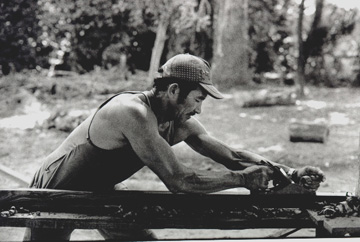 Artisan planing wood with the OCT project in the Nuquini Community, near Santarem, Para. Photo by: Dr. McGrath, Woods Hole Research Center. Photo courtesy of Ecostasy. |
The search for partner-communities and unique hand-crafted products was not easy, and according to Ponte is on-going. Ecostasy is in the midst of talking with four additional indigenous groups to start-up a partnership.
“We made every effort possible to identify individuals and communities living harmoniously with nature and producing high quality products in these regions using these raw materials responsibly. […] We travelled to seven Brazilian states to meet with artisans directly and visited innumerable local traditional fairs to identify and meet suppliers,” Ponte says.
The unique business model employed by Ponte has come to be known in some circles as ’boutique’ capitalism, whereby forestry or other extractive industries are replaced by communities making top-quality items for eco-minded consumers. An example of this is the Caboclo Workshops (or OCT) which produces ‘rustic’ furniture in the Amazon for Ecostasy.
“The Caboclo Workshop participants began making small furniture and other small household objects by collecting and using the dead wood that was left in agricultural clearings; no trees had to be felled. OCT is currently comprised of about 45 woodworkers in 6 workshops in 6 communities located along the western shore of the Lower Tapajós River,” Ponte says, adding that, “[the project] traces its origins to the grassroots movement in the 1980s that developed to protect community territories from encroaching logging companies.”
This year Ecostasy has embraced the International Year of Biodiversity 2010 (IYB) by becoming an official partner in the UN celebration.
“Biodiversity is critical to Ecostasy. Our products showcase biodiversity without which our collection would not be what it is,” Ponte says.
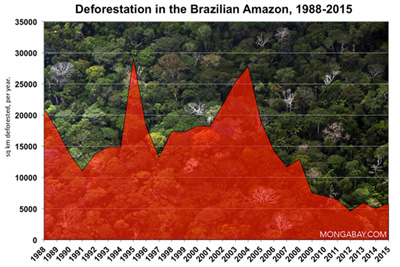 Click to enlarge |
While it may be difficult to for companies to become ‘green’, Ponte stresses that it is by no means impossible.
“I would encourage a company to step away from the trappings of green marketing and rather focus on what substantive action they can take to be green. This often requires thinking outside the box, pursuing a different shade of green. Green consumers are well informed and educated, and cosmetic green actions don’t get much traction over the longer term. More and more, consumers discern the difference between green marketing and green substance,” Ponte says.
In an October 2010 interview Katherine Ponte spoke to mongabay.com about Ecostasy’s mission and principles, how the company finds its artisans, its work with indigenous communities in the Amazon, and how companies can move beyond greenwashing to green.
AN INTERVIEW WITH KATHERINE PONTE
Mongabay: What are the guiding principles behind Ecostasy?
Katherine Ponte: Ecostasy is a conscious commerce destination for the informed, values-driven appreciation of curated objects that promote social and environmental good. The following principles frame our collection:
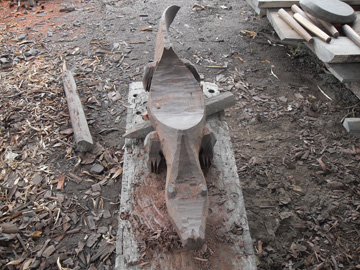 Near-finished product from the OCT project. Photo courtesy of Ecostasy. |
Handcrafted Beauty—Our products are made by hand in small volumes distinguished from the homogeneity of mass-produced offerings.
Inspired Design—Our designs marry progressive and traditional form and function with reverence to natural materials and shapes.
High Quality—Our objects are produced with exceptional craftsmanship, creativity and materials to endure for aesthetic enjoyment, inspiration and utility.
Natural and Renewable—Our products are made from natural and renewable materials including recycled and alternative resources.
Productive Conservation—We source objects fabricated using processes and materials that conserve natural resources and sustain ecologically important areas.
Social Preservation—Working with many community development projects, we seek partnerships that preserve traditional communities and habitats.
Accessibility—We seek to make our collection accessible at fair price points to a broader consumer base in order to foster more sustainable demand for our products and income streams for our producers.
Contextualization—We seek to provide visitors with an information-rich experience that provides full context for the object and further promotes an appreciation of its social and environmental value.
Collaboration—Our products are not easily sourced. In most cases, we are the first to make our products available outside Brazil. We seek partnerships that enhance our offering and are mutually rewarding to accomplish together more than we could alone.
It is important to emphasize that for us environmental conservation and social preservation are inextricably linked. A symbiotic relationship of giving and taking between the land and its inhabitants ensures each other’s survival. Through these principles, Ecostasy seeks to source unique, beautiful goods that promote this virtuous relationship while enlightening and satisfying refined consumer tastes.
Mongabay: What makes your company unique?
Katherine Ponte: Our company is unique in many respects: Mission – We have adapted an online sales model to offer a unique collection of sustainable designs at our destination ecostasy.com. We seek to promote and preserve endangered habitats and people by purchasing their products for resale and building awareness for their significance and cause on our information-rich site.
Sourcing—we set and follow our rigorous socially and environmentally responsible sourcing principles as discussed above.
Buying—we control each step of the acquisition process, whereas very few retailers of our scale do. We buy from our suppliers directly, we export out of Brazil, we import into the United States and we retail our products. We strongly believe retailers are the ultimate gatekeepers of socially and environmentally responsible sales. Traditional retail models understandably depend largely on wholesalers.
Also, in the traditional retail sourcing model, wholesalers are paid for goods, not artisans. In our model, we don’t have to worry about whether or not the wholesaler pays artisans on a fair and timely basis. We transact with each artisan directly, including fair and timely payments. Another aspect of the traditional sourcing model we find disconcerting is that wholesalers are largely interested in scale production. The inability to scale leaves many wonderful producers without a distribution channel. We hope to help fill this gap. Scale production is not, never will be, one of our sourcing criteria. Adherence to our sourcing principles governs our selection. Our sourcing principles allow us, proudly so, to offer a unique wonderful collection of products, rarely offered outside their local domestic markets.
Logistics—our logistics process is complex, namely export out of Brazil, import into the United States and coordinating over 50 suppliers throughout Brazil whose products showcase Brazil’s tremendous biodiversity. Given the complexity, we are very hands-on throughout the logistics possible to enhance execution and cost and time efficiencies.
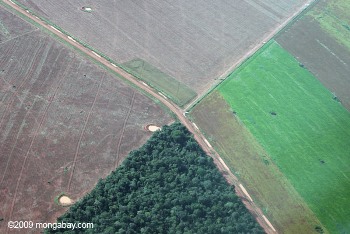 Clearing for pasture in the Amazon borders a legal forest reserve. Photo by: Rhett A. Butler. |
Retail—Unlike many online vendors of Brazilian designs, we invest in inventory which we transport to the United States principally by sea container. Sea container transport has a much lower carbon footprint than air transport. Other vendors do not invest in inventory, but offer products using a consignment model and focus resources on marketing. With regard to operations focused on fair trade products, we take some issue with the focus on “poverty” in marketing. Yes, we buy products from individuals and communities that some fair trade wholesalers and retailers may call “poor”. However, many of our suppliers are “rich”—extraordinarily “rich” in many important aspects, namely family, culture, tradition, skill and character. We do not sell products made by the “poor”, but “rich” people whose creations and influences are valuable and to be appreciated.
Consumers can and do play a critical role in retailing models. When consumers buy a product from us, they are collaborating with us and furthering our vision of a fair and just retailing model. We hope more and more consumers will invest in our socially and environmentally enhanced retail model.
Mongabay: How do you find the products you sell?
Katherine Ponte: We carefully research each product we sell. To promote productive conservation, one of our sourcing principles, we identified regions and raw materials of environmental importance. We made every effort possible to identify individuals and communities living harmoniously with nature and producing high quality products in these regions using these raw materials responsibly. In addition to artisans residing within environmentally sensitive regions, we researched many artisans and designs in urban spaces producing socially and environmentally responsible products. We travelled to seven Brazilian states to meet with artisans directly and visited innumerable local traditional fairs to identify and meet suppliers. We also received assistance with this process from local government, scientific and non-profit organizations. This research process took nearly a year to undertake, and we know we are still scratching the surface.
Mongabay: Ecostasy’s products are sourced from some of the most ecologically important and sensitive places in the world. How do you make certain products are sustainably sourced?
Katherine Ponte: From the outset, as mentioned above, it was important for us to source from ecologically important and sensitive places. Our suppliers from these areas depend on the sustainable management of natural resources for their craft. The “traditional” (as original inhabitants of these areas are called), “indigenous” and “quilombo” communities are important guardians of these ecologically sensitive areas and must be supported. In my travels to these regions, many members of traditional communities expressed a strong desire to “live in place” and resist leaving their communities for the city. Unfortunately, the lack of economic opportunities forces many traditional peoples to search for work in other areas, in the cities, thereby decreasing their important “guardian” presence at home. These traditional habitats, therefore, become susceptible to outsiders who wish to undertake activities that often harm the natural environment.
In addition to conferring with experts in these areas, for example environmental academics, NGOs and government agencies, where possible, we sought third-party documentation of product origins and responsible production. We were especially strict on items made of wood. For example, all but one of our suppliers of wood products presented us either FSC (Forestry Stewardship Council) or IBAMA (the Brazilian environmental body) written certification that the wood was responsibly sourced. The exception was a small NGO, which has been recognized and praised for its work with wood residues. On the point of certification, it is important to note that the certification process, be it FSC or Fair Trade, is too difficult and costly for some eligible suppliers. I would like to see more initiatives on the part of the FSC and other certification organizations to streamline certification processes for worthy small producers. We personally give preference to suppliers that may provide certification, but based on our due diligence we also source from suppliers without certifications.
AMAZON PROJECTS
Mongabay: The Brazilian Amazon has become one of the most important places for your company. What drew Ecostasy there?
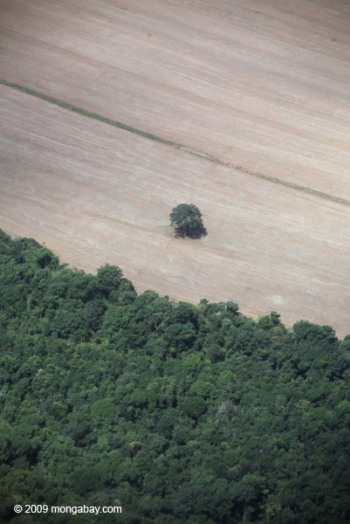 Lone Brazil nut tree in deforested area in Brazil. According to a new environmental index, of the world’s nations Brazil has the greatest environment impact. Deforestation was one of the factors included in the index’s findings. Photo by: Rhett A. Butler. |
Katherine Ponte: The Amazon, the world’s largest tropical rainforest, is called the “lungs of the world” since it plays such a critical role in the global carbon cycle which in turn effects global climate. More specifically, Brazil is home to over-half of the Amazon Rainforest, with the Amazon, covering 50 percent of Brazil’s landmass. In addition to its environmental significance, the Amazon flora’s tremendous genetic and pharmaceutical potential is incalculable. Its global significance as one of earth’s most important carbon banks and critical need for its preservation cannot be overstated. For these reasons, the Amazon is very important for Ecostasy.
In this context, it is extremely important to understand that the Amazon is not uninhabited. It is home to a substantial number of indigenous and traditional populations of anthropological and cultural importance. Over 200 indigenous languages are spoken in the region. Many of these populations still practice and preserve lifestyles and customs that have existed for thousands of years, living harmoniously with nature. Also, nearly 25 million Brazilians inhabit the nine states located within the Amazon region.
It is worth noting that Brazil is also home to other globally important and sensitive ecosystems, notably the Cerrado, the world’s most biodiverse savanna, the Atlantic Forest which is extremely biodiverse and the Pantanal, the world’s largest freshwater wetland.
A key principle of sourcing from the Amazon is to maintain traditional populations in forest areas, which is their overwhelming preference. Community-based initiatives focused on sustainable development of traditional crafts are also important tools in environmental protection. Handcrafted objects celebrate one of the highest forms of sustainable production—preserving communities in their local habitats generating income through traditional practices working in harmonious collaboration with nature. These efforts enable traditional communities to be the best environmental stewards possible, providing effective alternatives to destructive practices exercised out of economic necessity. Crafts also yield higher income than extractive activities reflecting their higher value added. Efforts by local and international bodies to provide oversight and guidance in such areas as certification that materials are responsibly sourced and production processes are important components of these initiatives.
Our collection provides individual consumers the opportunity to contribute to social and environmental good by purchasing a high quality object caringly made and sourced. Furthermore, our information-rich user experience at ecostasy.com seeks to promote the appreciation of the product’s what, where, why and how. We hope our product offering and user experience will serve as a conduit to places and peoples and encourage their preservation.
Mongabay: Will you tell us about the Caboclas Project?
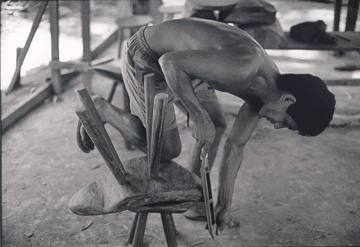 Artisan filing wood with the OCT project in the Nuquini Community, near Santarem, Para. Photo by: Dr. McGrath, Woods Hole Research Center. Photo courtesy of Ecostasy. |
Katherine Ponte: According to the Woods Hole Research Institute: “in a few places, an alternative strategy for community-based forestry is emerging that could be called ’boutique’ capitalism, in contrast to the ‘commodity’ capitalism approach that characterizes conventional forestry. This approach combines small-scale, technologically and organizationally simple production of high quality finished products for green consumer markets.”
One such ’boutique capitalism’ initiative is ‘OCT’ or the Caboclo Workshops of the Tapajós region of the Brazilian Amazon. Named for the local caboclo peoples of mixed European, African, and indigenous descent, the Caboclo Workshop participants began making small furniture and other small household objects by collecting and using the dead wood that was left in agricultural clearings; no trees had to be felled. OCT is currently comprised of about 45 woodworkers in 6 workshops in 6 communities located along the western shore of the Lower Tapajós River. The project builds on the sustainable forestry experiences of other projects in the Amazon. It traces its origins to the grassroots movement in the 1980s that developed to protect community territories from encroaching logging companies.
This local grassroots movement community led to the creation of the Tapajós Arapiuns Extractive Reserve (RESEX) in 1998 effectively protecting their lands from logging companies. Then, in 1999, the Amazon Environmental Research Institute (IPAM) contacted several Resex communities to determine their interest in developing sustainable forestry projects. Based on these initial discussions, the production of “rustic” furniture and other products using wood and natural materials was proposed. From 2001-2002, under the guidance of Dr. Charles Peters of the New York Botanical Gardens, forest management plans were completed. In 2001, OCT began marketing its products through local fairs and, in subsequent years, achieved several important commercial milestones. Importantly, since the early 2000s, the scientists of the Woods Hole Research Center have worked directly with OCT.
Mongabay: How does this project ensure sustainable forestry in the Amazon?
Katherine Ponte: As mentioned above, the project was developed with the institutional expertise of the IPAM (the Amazon Environmental Research Institute), the Woods Hole Research Institute and the New York Botanical Gardens. The groups began by using wood from downed trees while they developed management plans for sustainable use of their timber resources.
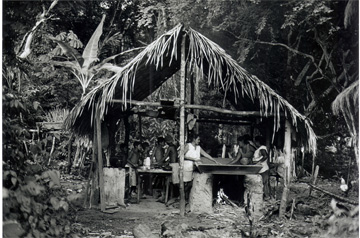 Artisans work in a hut. Photo by: Dr. McGrath, Woods Hole Research Center. Photo courtesy of Ecostasy. |
The project’s approach to sustainable forestry in the Amazon is perhaps best described by the Woods Hole Institute: “”the strategy for work with the OCT Cooperative consists of four main elements that distinguish this approach from that taken by the majority of community forestry initiatives that are based on timber production. First, the focus is on production of rustic furniture using hand tools most of which are available locally. Second, the organizational structure is consistent with the experience and capacity of members. Third, rather than exploiting all commercial timber on a 30-40 year cycle, the management system extracts the annual increment in growth of timber volume. Fourth, the project takes an incremental approach in which organizational and technological complexity increase in step with the development of group capacity.”
The OCT is an exemplary model for projects in ecologically important and sensitive places in the world. It is an example of collaboration between international environmental institutions and local communities to create and develop best practices for these important areas.
Mongabay: What are the ways in which handicraft production, such as in Caboclas, help local people?
Katherine Ponte: Handcrafted production, with the OCT project as an excellent example for sustainable forestry, can provide an important source of income for traditional communities. Craft production can yield higher income than other extractive activities reflecting their higher value added. It helps craftspeople remain in their communities, reducing the need to seek alternative activities outside their homes and habitats.
Mongabay: Will you tell us about the Apurinã people?
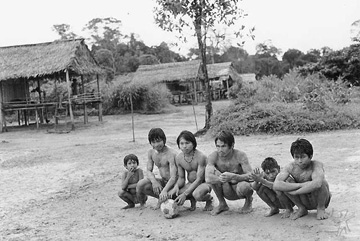 Apurinã men in 1984. Photo by: Nietta Lindenberg Monte. Photo courtesy of Ecostasy. |
Katherine Ponte: The Apurinã indigenous peoples are found along the margins of the Purus River in Acre and Rondonia states in the Brazilian Amazon. The first researchers, travelers and missionaries to reach the Purus River in the 19th century reported that, although the Apurinã lived some distance from the river’s edge, they traveled to the margins of the Purus River to fish and catch turtles. In 2006, the Apurinã population was estimated to be over 3,000, though the total population is uncertain. Much of the Apurinã’s modern history has been influenced by rubber exploration, and recognition of traditional Apurinã lands continues to be a challenge, often leading to conflicts with loggers and ranchers. Products are made by a group comprised of 42 families that survive on forest extraction of nuts, fibers, and seeds for craft production, fishing and farming. The group produces a variety of necklaces and other jewelry items from natural forest materials reflecting traditional practices and influences.
Mongabay: What threatens their way of life?
Katherine Ponte: One of the principle challenges of the Apurinã people is the regulation of traditional areas of the Apurinã that they still inhabit but have not been officially recognized and protected as Apurinã habitats. Land control in the Amazon is made particularly challenging given the awesome vastness and ruggedness of its terrain complicated by long standing uncertainties about land title in the region. This situation leaves traditional Apurinã habitats vulnerable to encroachment and pollution from clearing for activities such as cattle ranching and farming. For example, their habitat alongside a highway between the Rio Branco and Boca do Acre has been completely cleared for farming. This clearing has led to pollution of traditional fishing grounds and disruptions to hunting areas which threaten Apurinã access to basic food sources.
In this context, I would highlight that Amazon resource use encompasses a highly nuanced and controversial range of issues, complicated by various social, economic and environmental stakeholders. The strong association between deforestation and global climate change turns this debate decidedly international. Balancing and addressing the interests of these disparate constituencies will be critical to successful reform, requiring a multi-disciplinary approach. For instance, it is important to recognize that migration into now threatened areas was largely driven by government incentives to settle undeveloped regions during Brazil’s military dictatorship of the 1970s, resembling North America’s own frontier expansion. The investments and efforts of these settlers must also be recognized in the region’s protection and sustainable economic development initiatives. These types of programs fueled the growth of Brazil’s agricultural and cattle industries which are nationally and globally significant, exporting to meet the growing demands of developing counties such as China and developed countries such as the United States. Providing for the responsible and healthy growth of these industries will be a critical component of reform.
Mongabay: How did you partner with the Apurinã to sell their jewelry?
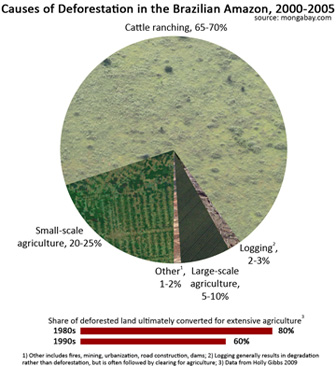
|
Katherine Ponte: In our travels, we identified a common necklace worn in various indigenous communities, the Tucumã necklace. Their prevalence may be attributed to local indigenous lore, which considers tucumã strings powerful protective charms when entering the forest. After several inquiries we learned that the Apurinã produced this necklace. We contacted the Apurinã to purchase samples and then placed a larger order with them for Tucumã, Ienaja and Jarina necklaces. We personally met with one of the group’s leaders to complete our purchase.
Mongabay: How could projects such as those with the Apurina and Caboclas be replicated in South America or other parts of the world?
Katherine Ponte: I am confident that projects such as the Apurinã and Caboclas may be replicated in South America and other parts of the world. Individuals and institutions have to be willing to invest time and effort into these types of relationships. There is a need for mutual respect and understanding to undertake these efforts. Personally speaking, I love traveling and meeting with artisans. I find it highly rewarding, and I have learned a great deal from my suppliers.
Mongabay: How can companies improve their relationships with indigenous groups in Brazil?
Katherine Ponte: Mutual respect. This is easily stated, but putting it into action is often difficult. From the beginning, I very much wanted to have several indigenous suppliers. My first collection includes seven indigenous communities, and I am in talks with four more. At the outset, when I mentioned my interest in sourcing from indigenous communities, I was greeted with skepticism and told by several local people that this sort of sourcing would not be possible. However, I am persistent. Based on my experience, yes, it is more difficult to make initial contact, but once I did I was able to transact quite smoothly. I have nothing but good to speak of my relationships with indigenous groups. The best approach is to keep an open mind when dealing with indigenous communities and treat them professionally and with respect.
ENVIRONMENTAL ISSUES
Mongabay: Why is biodiversity important to Ecostasy?
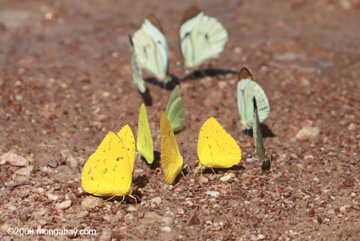 Butterflies in Brazil. Photo by: Rhett A. Butler. |
Katherine Ponte: Biodiversity is critical to Ecostasy. Our products showcase biodiversity without which our collection would not be what it is. As part of our commitment to biodiversity and efforts to promote greater awareness of its importance, we became an official Partner of the International Year of Biodiversity 2010 (IYB), an initiative of the United Nations. Under this partnership, we will donate all profits from the sale on our site of t-shirts commemorating IYB to a leading environmental non-governmental organization (NGO) in Brazil. Ecostasy’s mission is inextricably linked to biodiversity, and we continue to seek complementary ways to use our platform to promote biodiversity, in addition to our product and rich site content offering.
Mongabay: What advice would you give to a company that desires to become more ‘green’?
Katherine Ponte: I would encourage a company to step away from the trappings of green marketing and rather focus on what substantive action they can take to be green. This often requires thinking outside the box, pursuing a different shade of green. Green consumers are well informed and educated, and cosmetic green actions don’t get much traction over the longer term. More and more, consumers discern the difference between green marketing and green substance.
Mongabay: Recently there has been no end to news stories about companies committing unethical acts. In your mind what is a ‘virtuous’ company?
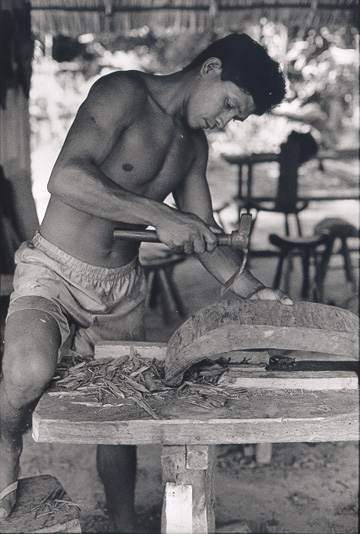 Artisan chipping wood with the OCT project in the Nuquini Community, near Santarem, Para. Photo by: Dr. McGrath, Woods Hole Research Center. Photo courtesy of Ecostasy. |
Katherine Ponte: In my mind, a virtuous company does not compromise ethical principles for economic interests. For me, being ethical is comprised of conducting oneself with honesty and responsibility to one’s constituencies (customers, employees, suppliers), society and the environment.
Mongabay: What do you think stands in the way of more companies taking a true stand against environmental destruction and undercutting indigenous rights?
Katherine Ponte: Preconceived notions, lack of professionalism, unwillingness to negotiate and, first and foremost, economic self-interest.
Mongabay: Will you tell us the story behind one of your favorite products?
Katherine Ponte: I have many favorites. One of my favorite products has got to be the Goiabeiras Pottery. Clay pot making is a centuries-old tradition in this Goiabeiras area of the northeastern Brazilian state of Espírito Santo. The pot making technique is of indigenous origin—clay is molded by hand, fired in open air and coated with “tanino”, a coloring obtained from the bark of the Mangue tree. The raw materials are all locally sourced, and the pots are made by women who pass the technique on to their daughters. The pots are indispensable for the preparation and serving of Moqueca Capixaba (Espírito Santo fish stew), central to the region’s culinary and cultural identity. Capixaba (or Espírito Santo) cuisine has been recognized nationally as among the “most Brazilian” of cuisines as it unites indigenous, African and Portuguese cultural influences. The Moqueca cuisine dates back over 400 years. The artisanal production of pots in Goiabeiras was officially registered as Brazilian Patrimônio Cultural or Intangible Cultural Heritage in 2002.
What is so appealing to me about the Goiabeira Pottery, like so many craft items and designs in our collection, is how an object embodies the traditions and cultures of a place and people. These pots are truly vessels reflecting the power of craft to convey and preserve cultural value while appealing to aesthetic and physical tastes.
Related articles
The Nestlé example: how responsible companies could end deforestation

(10/06/2010) The NGO, The Forest Trust (TFT), made international headlines this year after food giant Nestlé chose them to monitor their sustainability efforts. Nestlé’s move followed a Greenpeace campaign that blew-up into a blistering free-for-all on social media sites. For months Nestle was dogged online not just for sourcing palm oil connected to deforestation in Southeast Asia—the focus of Greenpeace’s campaign—but for a litany of perceived social and environmental abuses and Nestlé’s reactions, which veered from draconian to clumsy to stonily silent. The announcement on May 17th that Nestlé was bending to demands to rid its products of deforestation quickly quelled the storm. Behind the scenes, Nestlé and TFT had been meeting for a number of weeks before the partnership was made official. But can TFT ensure consumers that Nestlé is truly moving forward on cutting deforestation from all of its products?
Conserving nature with economics

(09/29/2010) While many factors come into consideration when the fate of forests are being determined, economics often play a key role in land use decisions. When the perceived value of forest land is higher as cattle pasture, cropland, or plantation, then trees fall. But what happens when economic assumptions underlying these decisions are wrong? Forests, including the services they provide and the biodiversity they shelter, are lost in vain, much to the detriment of society and the planet. Working to avoid these costly outcomes is the Conservation Strategy Fund (CSF), a California-based nonprofit that trains conservationists to use economics and strategic thinking as assets to conserve natural ecosystems in countries around the globe. CSF runs training programs that help emerging conservation leaders build and strengthen parks, influence policies, and avert damage from infrastructure projects.
Paying for nature: putting a price on ‘ecosystem services’
(07/12/2010) Ever since humans entered the stage, nature has been providing us with a wide-variety of essential and ‘free’ services: food production, pollination, soil health, water filtration, and carbon sequestration to name a few. Experts have come to call these ‘ecosystem services’. Such services, although vital for an inhabitable planet, have largely gone undervalued in the industrial age, at least officially. Yet as environmental crises pile one on another across the world, a growing number of scientists, economists, environmentalists, and policy-makers are beginning to consider putting a monetary value on ‘ecosystem services’.
Collapsing biodiversity is a ‘wake-up call for humanity’
(05/10/2010) A joint report released today by the Convention on Biological Diversity (CBD) and the UN Environment Program (UNEP) finds that our natural support systems are on the verge of collapsing unless radical changes are made to preserve the world’s biodiversity. Executive Secretary of the Convention on Biological Diversity, Ahmed Djoghlaf, called the bleak report “a wake-up call for humanity.”
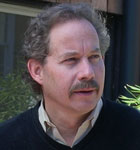
(05/03/2010) Over the past 30 years billions of dollars has been committed to global conservation efforts, yet forests continue to fall, largely a consequence of economic drivers, including surging global demand for food and fuel. With consumption expected to far outstrip population growth due to rising affluence in developing countries, there would seem to be little hope of slowing tropical forest loss. But some observers see new reason for optimism—chiefly a new push to make forests more valuable as living entities than chopped down for the production of timber, animal feed, biofuels, and meat. While are innumerable reasons for protecting forests—including aesthetic, cultural, spiritual, and moral—most land use decisions boil down to economics. Therefore creating economic incentives to maintaining forests is key to saving them. Leading the effort to develop markets ecosystem services is Forest Trends, a Washington D.C.-based NGO that also organizes the Katoomba group, a forum that brings together a wide variety of forest stakeholders, including the private sector, local communities, indigenous people, policymakers, international development institutions, funders, conservationists, and activists.
Farming snails to save the world’s rarest gorillas
(04/28/2010) In a place of poverty and hunger, how do you save a species on the edge of extinction? A difficult question that conservationists have long-been working to tackle, the Wildlife Conservation Society (WCS) has come up with a new plan to protect the world’s most endangered gorilla, the Cross River gorilla, from poachers by providing locals with an alternate and better income from farming snails.














